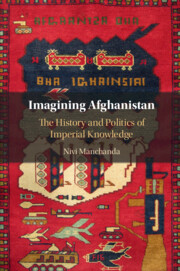Book contents
- Imagining Afghanistan
- Imagining Afghanistan
- Copyright page
- Dedication
- Epigraph
- Contents
- Figures
- Acknowledgements
- Introduction
- 1 The Construction of Afghanistan as a ‘Discursive Regime’
- 2 A Space Contested, or the ‘State’ of Afghanistan
- 3 The Emergency Episteme of the ‘Tribe’ in Afghanistan
- 4 Framed
- 5 Subversive Identities
- Coda
- References
- Index
1 - The Construction of Afghanistan as a ‘Discursive Regime’
Published online by Cambridge University Press: 09 June 2020
- Imagining Afghanistan
- Imagining Afghanistan
- Copyright page
- Dedication
- Epigraph
- Contents
- Figures
- Acknowledgements
- Introduction
- 1 The Construction of Afghanistan as a ‘Discursive Regime’
- 2 A Space Contested, or the ‘State’ of Afghanistan
- 3 The Emergency Episteme of the ‘Tribe’ in Afghanistan
- 4 Framed
- 5 Subversive Identities
- Coda
- References
- Index
Summary
Through an analysis of some of the stock tropes (as a pawn in the Great Game, as a space of disease and pathology and as the graveyard of empires) used to describe Afghanistan, and through a close reading of one key text (Afghanistan 101), the first chapter highlights the ways in which a certain essentialised ‘idea’ of Afghanistan has become common-sense and has disguised the need for more serious engagement with the country and its people. The aim of this chapter is to foreground Afghanistan as an object of enquiry and to start questioning some of the strategies that are most commonly used to think about it.
- Type
- Chapter
- Information
- Imagining AfghanistanThe History and Politics of Imperial Knowledge, pp. 23 - 65Publisher: Cambridge University PressPrint publication year: 2020

